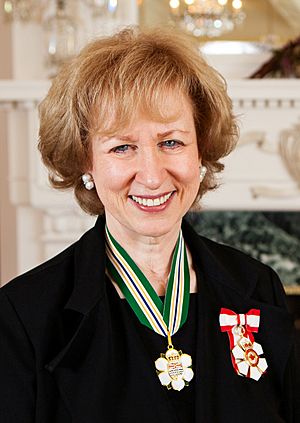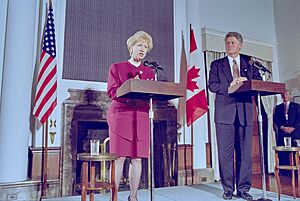Kim Campbell facts for kids
Quick facts for kids
Kim Campbell
|
|||||||||||||||||||||||||||||||||||||||||||||||
|---|---|---|---|---|---|---|---|---|---|---|---|---|---|---|---|---|---|---|---|---|---|---|---|---|---|---|---|---|---|---|---|---|---|---|---|---|---|---|---|---|---|---|---|---|---|---|---|

Campbell in 2012
|
|||||||||||||||||||||||||||||||||||||||||||||||
| 19th Prime Minister of Canada | |||||||||||||||||||||||||||||||||||||||||||||||
| In office June 25 – November 4, 1993 |
|||||||||||||||||||||||||||||||||||||||||||||||
| Monarch | Elizabeth II | ||||||||||||||||||||||||||||||||||||||||||||||
| Governor General | Ray Hnatyshyn | ||||||||||||||||||||||||||||||||||||||||||||||
| Deputy | Jean Charest | ||||||||||||||||||||||||||||||||||||||||||||||
| Preceded by | Brian Mulroney | ||||||||||||||||||||||||||||||||||||||||||||||
| Succeeded by | Jean Chrétien | ||||||||||||||||||||||||||||||||||||||||||||||
| Leader of the Progressive Conservative Party of Canada | |||||||||||||||||||||||||||||||||||||||||||||||
| In office June 13 – December 14, 1993 |
|||||||||||||||||||||||||||||||||||||||||||||||
| Preceded by | Brian Mulroney | ||||||||||||||||||||||||||||||||||||||||||||||
| Succeeded by | Jean Charest | ||||||||||||||||||||||||||||||||||||||||||||||
|
|||||||||||||||||||||||||||||||||||||||||||||||
| Member of Parliament for Vancouver Centre |
|||||||||||||||||||||||||||||||||||||||||||||||
| In office November 21, 1988 – October 25, 1993 |
|||||||||||||||||||||||||||||||||||||||||||||||
| Preceded by | Pat Carney | ||||||||||||||||||||||||||||||||||||||||||||||
| Succeeded by | Hedy Fry | ||||||||||||||||||||||||||||||||||||||||||||||
| Member of the British Columbia Legislative Assembly for Vancouver-Point Grey |
|||||||||||||||||||||||||||||||||||||||||||||||
| In office September 24, 1986 – November 21, 1988 Serving with Darlene Marzari
|
|||||||||||||||||||||||||||||||||||||||||||||||
| Preceded by |
|
||||||||||||||||||||||||||||||||||||||||||||||
| Succeeded by | Tom Perry | ||||||||||||||||||||||||||||||||||||||||||||||
| Personal details | |||||||||||||||||||||||||||||||||||||||||||||||
| Born |
Avril Phaedra Douglas Campbell
March 10, 1947 Port Alberni, British Columbia, Canada |
||||||||||||||||||||||||||||||||||||||||||||||
| Political party | Independent (since 2003) | ||||||||||||||||||||||||||||||||||||||||||||||
| Other political affiliations |
|
||||||||||||||||||||||||||||||||||||||||||||||
| Spouses |
Howard Eddy
(m. 1986; div. 1993)Hershey Felder
(m. 1997) |
||||||||||||||||||||||||||||||||||||||||||||||
| Alma mater | |||||||||||||||||||||||||||||||||||||||||||||||
| Occupation |
|
||||||||||||||||||||||||||||||||||||||||||||||
| Signature | |||||||||||||||||||||||||||||||||||||||||||||||
Avril Phaedra Douglas "Kim" Campbell (born March 10, 1947) is a Canadian politician. She made history as the 19th prime minister of Canada, serving from June to November 1993. Kim Campbell was the first and, so far, only woman to hold this important position in Canada.
Before becoming prime minister, she achieved other significant "firsts." She was the first woman to be the Minister of Justice in Canada. She was also the first woman to become the Minister of Defence in any country that was part of NATO (North Atlantic Treaty Organization).
Campbell began her political career in British Columbia. She was elected to the provincial assembly in 1986. Later, in 1988, she became a Member of Parliament in the House of Commons of Canada. Under Prime Minister Brian Mulroney, she held several important roles. These included Minister of Justice, Minister of Veterans Affairs, and Minister of National Defence.
She became prime minister in June 1993 after Brian Mulroney stepped down. However, her time as prime minister was short, lasting 132 days. This makes her premiership the third-shortest in Canadian history. In the 1993 Canadian federal election that October, her party, the Progressive Conservatives, lost many seats. Kim Campbell also lost her own seat in that election.
Kim Campbell was also the first prime minister born in British Columbia. She was also the first prime minister from the "baby boomer" generation.
Contents
Early Life and Education
Kim Campbell was born on March 10, 1947, in Port Alberni, British Columbia. Her parents were Phyllis and George Campbell. Her father was a lawyer and had served in the military.
When Kim was young, her family moved to Vancouver. She even appeared on a CBC Television children's show called Junior Television Club in 1957.
When she was 12, her mother left, and Kim and her sister were raised by their father. As a teenager, she started using the nickname "Kim." She was an excellent student at Prince of Wales Secondary School. She became the first female student president there and graduated in 1964.
University Studies and Early Career
Kim Campbell studied political science at the University of British Columbia. She earned her bachelor's degree in 1969. She was very involved in student life and was the first female president of her freshman class.
She continued her studies, including a year at the London School of Economics in 1970. There, she focused on the government of the Soviet Union. She also spent time learning the Russian language.
After returning to Vancouver, she married Nathan Divinsky in 1972. She later earned a law degree (LL.B.) from the University of British Columbia in 1983. In 1984, she became a lawyer in British Columbia and worked in Vancouver until 1986.
Family Life and First Steps in Politics
While married to Nathan Divinsky, Kim Campbell taught political science part-time. She also began her political journey as a trustee on the Vancouver School Board. She served on the board from 1980 to 1984. She became the chair of the board in 1983 and vice-chair in 1984.
Kim Campbell and Nathan Divinsky divorced in 1983. She later married Howard Eddy in 1986. This marriage ended before she became prime minister. She was the second Canadian prime minister to have been divorced.
Today, she is married to Hershey Felder, who is an actor, writer, and musician. As of 2022, she lived in Italy.
Provincial Politics in British Columbia
In 1983, Kim Campbell ran for a seat in the British Columbia Legislative Assembly. She was a candidate for the British Columbia Social Credit Party. She did not win this election.
However, her political career continued to grow. In 1985, she worked as an assistant and advisor for Premier Bill Bennett.
Seeking Party Leadership
In 1986, Kim Campbell decided to run for the leadership of the Social Credit party. Even though she had a small budget, her strong speeches made people notice her. She spoke about the importance of leaders understanding complex issues.
She emphasized that a good leader helps people understand challenges. She also warned that a leader with charm but no real ideas could disappoint people. She finished last in the leadership race but gained valuable experience.
Elected to the Legislature
In the 1986 election, Campbell ran again and was elected to the Legislative Assembly. She represented the Vancouver-Point Grey area. This was a special election because it was the only time this district elected two women from different parties.
During her time in the provincial assembly, she disagreed with Premier Bill Vander Zalm on some important issues. Because of these disagreements, she decided to leave provincial politics. She then set her sights on federal politics.
Federal Politics and Cabinet Roles
In the 1988 Canadian federal election, Kim Campbell was elected as a Member of Parliament (MP). She represented the Vancouver Centre area. In 1989, she joined the cabinet as the Minister of State for Indian Affairs and Northern Development. This was a junior role.
From 1990 to 1993, she held the important position of Minister of Justice and Attorney General. In this role, she helped update Canada's laws. She introduced new laws to protect people from harm and ensure fairness.
In 1993, Campbell became the Minister of National Defence and Minister of Veterans Affairs. During this time, she dealt with important decisions about military equipment. She also faced challenges related to Canadian soldiers serving abroad, including a difficult situation known as the Somalia Affair.
Prime Minister of Canada (June–November 1993)

By 1993, Prime Minister Brian Mulroney's popularity had decreased. He announced he would retire from politics. Kim Campbell decided to run for the leadership of the Progressive Conservative Party of Canada. She had the support of many members of her party.
In June 1993, she won the leadership race, defeating Jean Charest. On June 25, she was sworn in as the 19th Prime Minister of Canada by Governor General Ray Hnatyshyn. She appointed Jean Charest as her Deputy Prime Minister.
As prime minister, Campbell made changes to the government. She reduced the number of cabinet ministers from 35 to 23. She also combined some government departments to create new ones, like Health and Canadian Heritage.
During the summer of 1993, Campbell traveled across Canada. She met many people and attended events. A poll in August 1993 showed she had a 51% approval rating. This made her one of Canada's most popular prime ministers in 30 years at that time.
The 1993 Federal Election
Campbell called a federal election for October 25, 1993. Her party, the Progressive Conservatives, hoped to stay in power.
The Election Campaign
As the election campaign continued, Campbell's popularity began to drop. Her honest way of speaking, which people liked at first, sometimes caused problems. For example, she said that big changes to Canada's social policies couldn't be fully discussed in just 47 days. This statement was sometimes misunderstood.
Support for the Progressive Conservatives fell during the campaign. The Liberal Party of Canada, led by Jean Chrétien, gained more support. The Reform Party of Canada and the Bloc Québécois also became stronger.
Election Defeat
On election night, October 25, the Progressive Conservatives lost the election. The Liberals won a large majority of seats. Kim Campbell herself lost her seat in Vancouver Centre to Hedy Fry.
The Progressive Conservatives won only two seats in Parliament. This was the worst result for a governing party in Canadian history. Kim Campbell's time as prime minister was very short, and Parliament never actually met while she was in office.
Some people believe that the party's previous leader, Brian Mulroney, left office at a difficult time. Others point to the election campaign itself as a reason for the loss.
On December 13, 1993, Kim Campbell resigned as the leader of the party. Jean Charest took over as the new leader. Because her time as prime minister and MP was so brief, she did not qualify for a prime ministerial or federal parliamentary pension.
Life After Politics
Even after her election loss, Chatelaine magazine named Kim Campbell its Woman of the Year for 1993. In 1996, she published her autobiography, Time and Chance, which became a bestseller in Canada.
From 1996 to 2000, she served as the consul general for Canada in Los Angeles. This meant she represented Canada's interests in that city.
She also became involved in international organizations. From 1999 to 2003, she chaired the Council of Women World Leaders. This group connects women who are or have been presidents or prime ministers. She also served as president of the International Women's Forum from 2003 to 2005.
From 2001 to 2004, she was a fellow at the John F. Kennedy School of Government at Harvard University. She has also served on the boards of several companies and international groups. These include the International Crisis Group, which works to prevent conflicts. She is also a founding member of the Club de Madrid, an organization of former heads of state and government who work to strengthen democracy.
In April 2014, Kim Campbell was appointed the founding principal of the new Peter Lougheed Leadership College at the University of Alberta.
In 2016, Prime Minister Justin Trudeau asked Campbell to lead a committee. This committee helped choose candidates for the Supreme Court of Canada. They recommended Malcolm Rowe, who became the first Supreme Court justice from Newfoundland and Labrador.
In September 2022, Campbell attended the state funeral of Elizabeth II in London.
Legacy and Impact
As Minister of Justice, Kim Campbell made important changes to Canadian law.
Even though she was prime minister for a short time, Campbell made big changes to how the Canadian government was structured. She reduced the size of the federal cabinet and reorganized many government departments. These changes were kept by the next government. She was also the first prime minister to meet with provincial leaders before attending the G7 Summit.
Historians have different views on Kim Campbell's time as Prime Minister. Some believe she faced a very difficult situation when she took office. Others suggest that her election campaign played a key role in the outcome.
The Progressive Conservative Party never fully recovered after the 1993 election. In 2003, the party merged with the Canadian Alliance to form the Conservative Party of Canada.
Kim Campbell remains one of the youngest women to have become prime minister in any country. She is also the only woman to have held this office in Canada. In 2004, the Almanac of World History included her in a list of 50 important political leaders. This was because of her unique status as the only female head of government in North America at the time.
In 2004, Kim Campbell's official portrait was unveiled for the prime minister's gallery in Parliament. The painting shows her with traditional Indigenous robes in the background. She expressed hope that many more women would join her portrait in the future.
Honours
| Ribbon | Description | Notes |
|---|---|---|
| Companion of the Order of Canada (C.C.) |
|
|
| Member of the Order of British Columbia (O.B.C.) |
|
|
| 125th Anniversary of the Confederation of Canada Medal |
|
|
| Queen Elizabeth II Golden Jubilee Medal for Canada |
|
|
| Queen Elizabeth II Diamond Jubilee Medal for Canada |
|
According to Canadian protocol, as a former prime minister, she is styled "The Right Honourable" for life.
- Appointed a Companion of the Order of Canada on Canada Day 2008
- Member of the Board, Forum of Federations.
Scholastic
Chancellor, visitor, governor, and fellowships
| Location | Date | School | Position |
|---|---|---|---|
| 2001 – | Center for Public Leadership John F. Kennedy School of Government at Harvard University | Honorary Fellow | |
| – | London School of Economics | Honorary Fellow | |
| – | Munk School of Global Affairs at the University of Toronto | Distinguished Senior Fellow |
Honorary Degrees
| Location | Date | School | Degree |
|---|---|---|---|
| 1992 | Law Society of Upper Canada | Doctor of Laws (LL.D) | |
| June 13, 1998 | Brock University | Doctor of Laws (LL.D) | |
| June 19, 1999 | Northeastern University | Doctor of Public Service (DPS) | |
| November 23, 2000 | University of British Columbia | Doctor of Laws (LL.D) | |
| 2004 | Mount Holyoke College | Doctor of Laws (LL.D) | |
| 2005 | Chatham College | Doctor of Laws (LL.D) | |
| December 15, 2005 | Arizona State University | Doctor of Humane Letters (DHL) | |
| Fall 2010 | University of Alberta | Doctor of Laws (LL.D) | |
| 2011 | Trent University | Doctor of Laws (LL.D) | |
| June 11, 2014 | Simon Fraser University | Doctor of Laws (LL.D) | |
| May 13, 2018 | Acadia University | Doctor of Civil Law (DCL) |
Appointments
| Location | Date | Institution | Position |
|---|---|---|---|
| January 30, 1989 – | Queen's Privy Council for Canada | Member (PC) | |
| – | Government of Canada | Queen's Counsel (QC) | |
| 1996–2000 | Government of Canada | Consul General to Los Angeles |
Memberships and Fellowships
| Location | Date | Organisation | Position |
|---|---|---|---|
| 2001– | Club of Madrid | Member | |
| 2003–2004 | Club of Madrid | vice President | |
| 2004–2006 | Club of Madrid | Secretary General | |
| 2003–2005 | Council of Women World Leaders | President |
Arms
Archives
There is a collection of Kim Campbell's records at Library and Archives Canada. This collection includes many documents, photographs, and videos from 1916 to 2004.
Kim Campbell Quotes
- "I have always believed governments must adapt to the needs of the people, not the other way around."
- "If you never encounter anything in your community that offends you, then you are not living in a free society."
- "I'd be prouder still to say I was Canada's 10th woman prime minister."
- "In all modesty, we must admit that governments are not always the best doctors when it comes to diagnosing economic ailments and prescribing the right treatment."
See also
 In Spanish: Kim Campbell para niños
In Spanish: Kim Campbell para niños
- Time and Chance (Kim Campbell)


